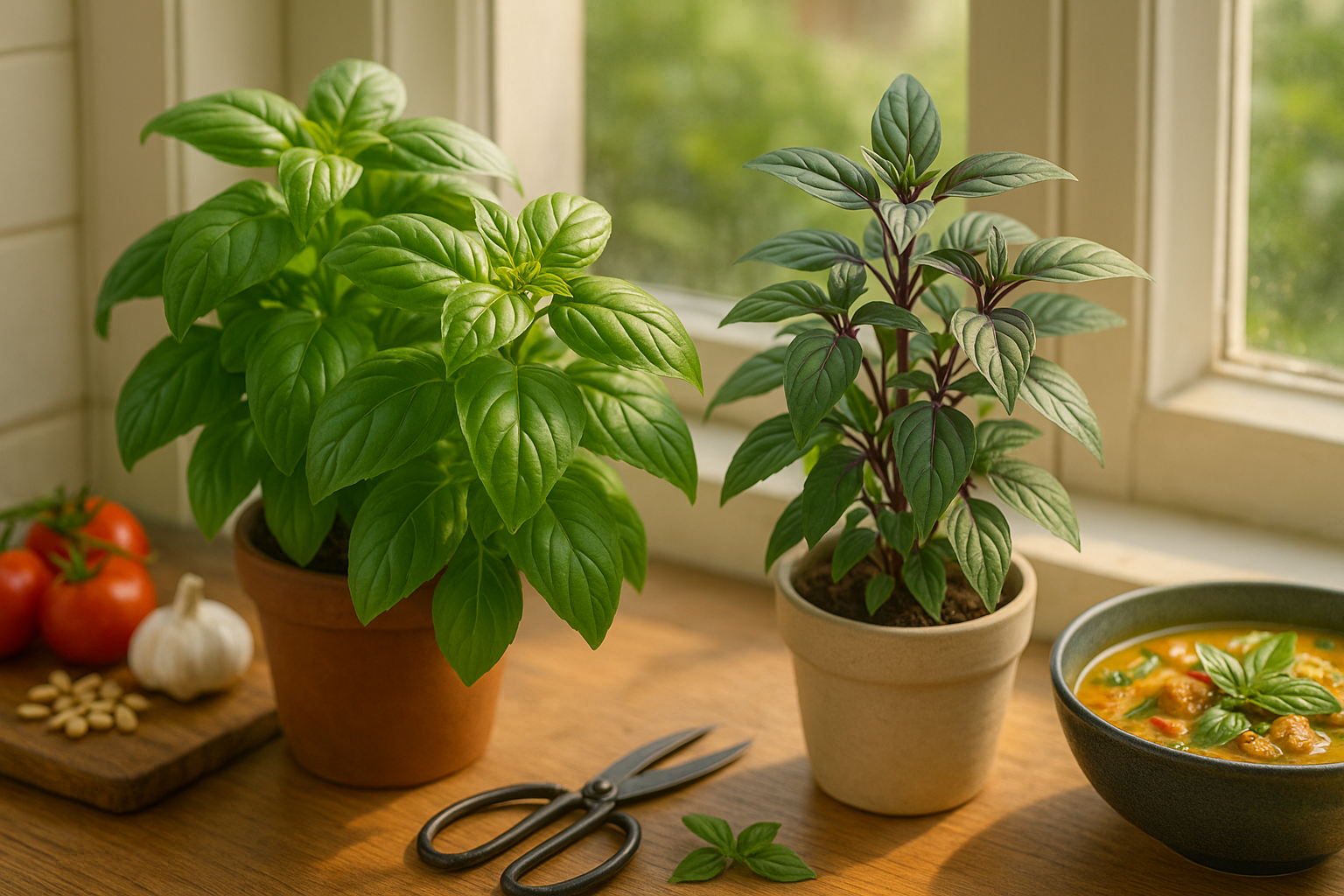Introduction
When it comes to elevating your recipes or home herb garden, the comparison between Genovese basil vs Thai basil is worth understanding. These two global basil varieties are staples in many kitchens but differ greatly in flavor, aroma, and appearance. Genovese basil—the classic Italian herb you’ll find in your favorite pesto—offers a sweet and slightly peppery taste that’s perfect for Mediterranean dishes. Thai basil, on the other hand, delivers a spicy, licorice-like punch, making it essential in Southeast Asian cooking like Thai curries and Vietnamese pho.
Many home cooks and gardeners get confused about which type to use in their dishes or how best to grow each, especially since both can thrive on a sunny windowsill or backyard garden. In this post, we’ll break down the key differences between Genovese and Thai basil—from their unique flavors and ideal culinary uses to their specific growing requirements. Whether you’re seeking the perfect basil to complement your homemade pasta or aiming to create a more diverse herb garden, understanding these varieties will help you choose and grow the right basil for your needs.
What is Genovese Basil?
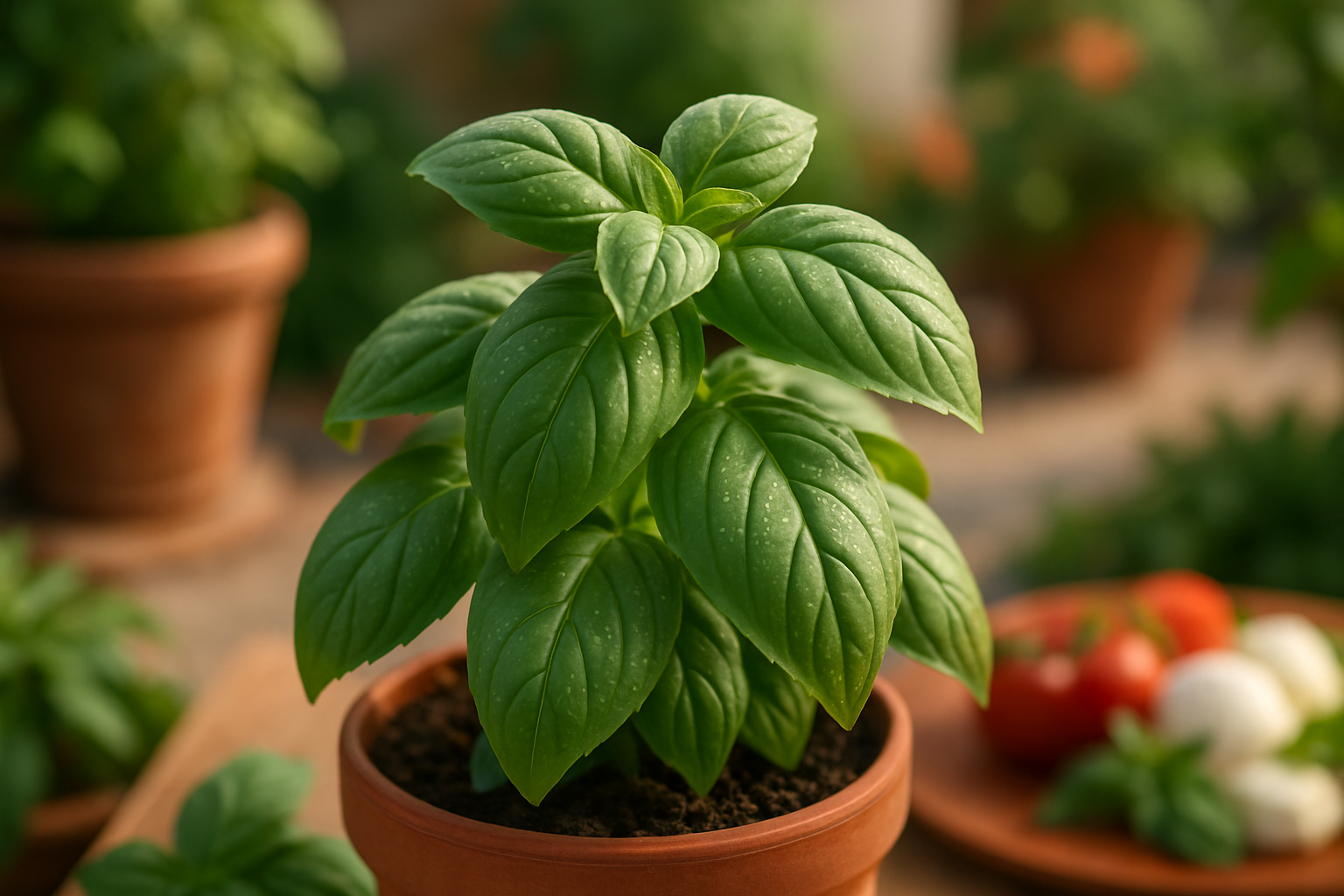
Genovese basil is a classic variety of sweet basil known for its vibrant green leaves. These leaves are broad, slightly cupped, and typically measure two to three inches long. They have a glossy sheen and a gentle, velvety texture, making them visually appealing and pleasant to handle in the kitchen.
This basil’s signature aroma is fresh, sweet, and mildly peppery, with hints of clove and anise—a fragrance that instantly evokes Mediterranean kitchens. Its flavor is equally distinctive: robust, slightly spicy, and deeply herbaceous. Because of this, it’s the traditional basil of choice for authentic Italian pesto, Caprese salad, and classic tomato sauces.
In Mediterranean cuisine, Genovese basil is often layered with tomatoes and mozzarella, tossed into pasta dishes, or blitzed into sauces where its bright, peppery notes truly shine. Beyond professional kitchens, it has earned enthusiastic adoption in home gardens across Europe and North America due to its easy growth, adaptability to containers, and prolific leaf production.
Gardeners love that regular harvesting encourages bushier growth, resulting in a continual supply of fresh leaves throughout the summer. Even a small pot on a sunny balcony can produce enough basil to elevate salads, sandwiches, and homemade dressings, making Genovese basil a staple herb for cooks who value fresh, bold flavors right at their fingertips.
What is Thai Basil?
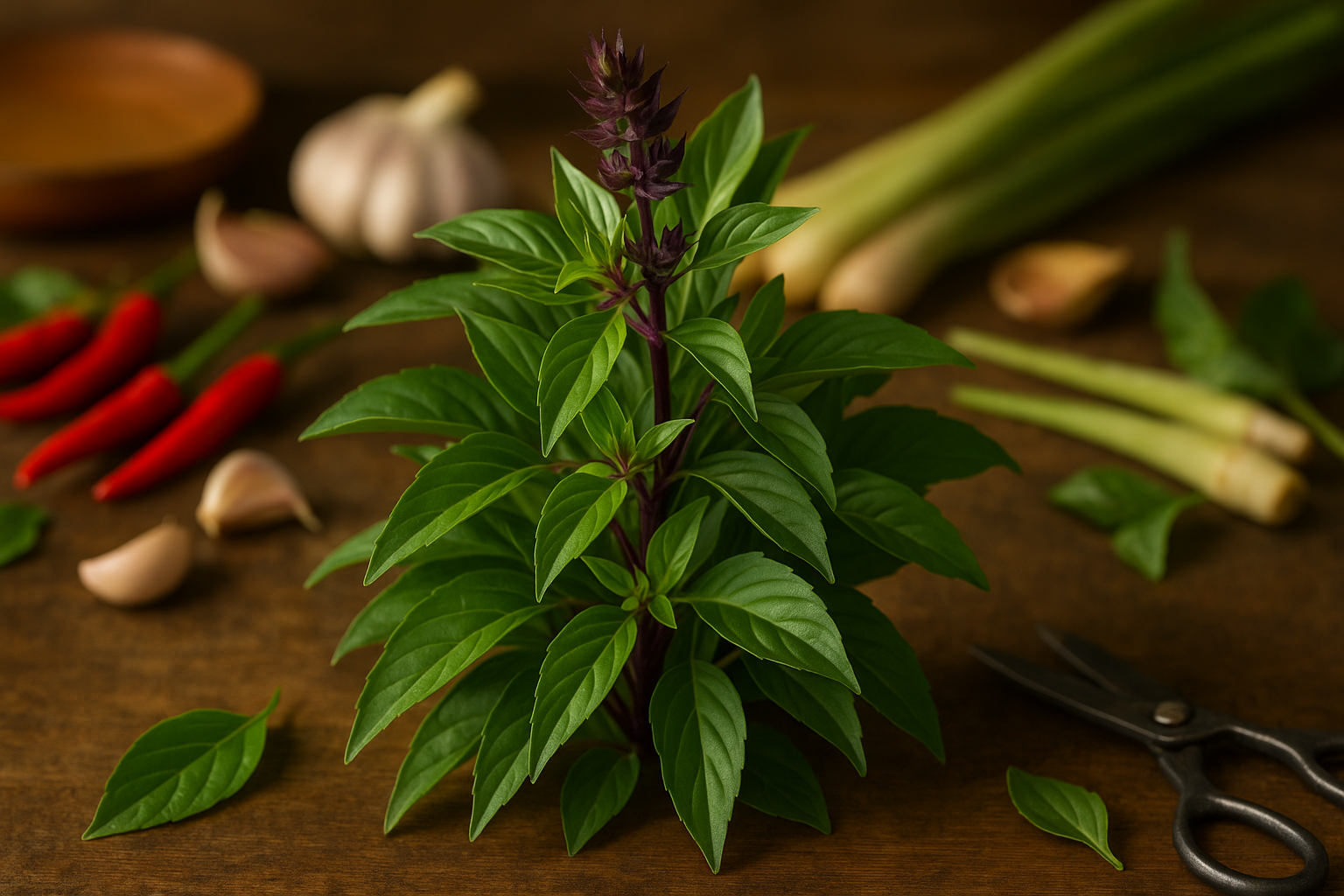
Thai basil is a vibrant, aromatic herb known for its eye-catching purple stems and slender, sharply pointed leaves. Unlike the sweet basil commonly found in Italian cuisine, Thai basil delivers a bold punch with its distinctly spicy, anise-like flavor—think licorice but brighter and more peppery. This signature taste makes it a staple ingredient in Southeast Asian cuisines, especially in Thai and Vietnamese dishes.
Next time you enjoy a bowl of Vietnamese pho or a spicy Thai stir-fry, look for sprigs of Thai basil served alongside. Tear the leaves and add them to your soup, or toss them into curries and noodle dishes for a fresh, herbal kick.
How Thai Basil Differs from Other Basils
Thai basil differs from its relatives in several key ways:
- Holy basil (also called “krapow” in Thai) has jagged, crinkled leaves and emits a clove-like aroma, perfect for fiery stir-fries.
- Lemon basil offers a citrusy, lemon-verbena scent that’s much lighter on the palate and is often used in salads or with seafood.
The easiest way to remember Thai basil is by its unique look and unmistakable fragrance—it’s not just a garnish but an essential ingredient that brings Southeast Asian cooking to life.
Growing Thai Basil
If you’re curious, try growing Thai basil yourself; it’s surprisingly hardy and thrives in warm, sunny spots. With its snappy flavor and striking appearance, Thai basil is one herb every adventurous cook should know.
Genovese vs Thai Basil
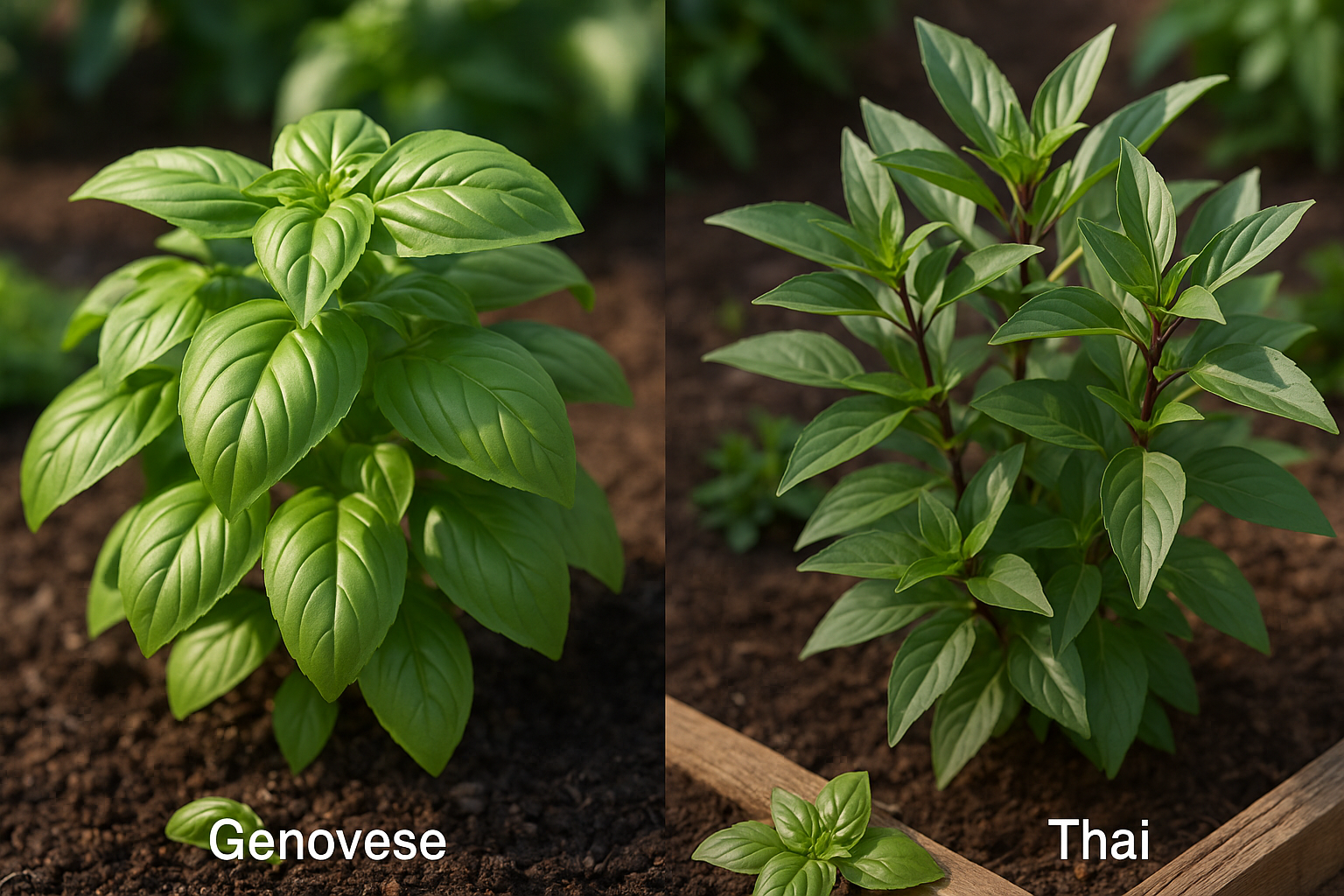
Genovese basil and Thai basil both belong to the mint family, but they differ in several key ways that can make a big impact in your kitchen. Genovese basil, known for its classic association with Italian cuisine, features large, smooth, bright green leaves that are soft to the touch and somewhat rounded. Its stems are green and tender, supporting a bushy, compact growth habit that flourishes in summer gardens.
In contrast, Thai basil showcases narrower, more elongated leaves with subtle serration along the edges and a distinct purple hue on its stems and flower spikes. Its foliage is often a deeper, almost glossy green and grows in a more upright, sometimes spindly formation. The aroma is a giveaway: Genovese basil offers a sweet, almost clove-like fragrance with strong hints of pepper and anise, while Thai basil releases a sharper, spicier scent reminiscent of licorice or even cinnamon.
Taste-wise, they stand apart even more. Genovese basil has a gentle peppery sweetness, ideal for pesto, Caprese salads, and other uncooked Italian dishes. When cooked, it melds beautifully with tomato-based sauces, though it can lose some fragrance if overheated—it’s best to add it at the end of cooking.
Thai basil, meanwhile, packs a punchier flavor profile, marked by bold anise and mint undertones with a touch of spice. This makes it a star in Southeast Asian cuisine, where its robust flavor stands up to chili, garlic, and bold sauces, retaining its aroma and taste even after simmering in curries or being tossed into hot broths like pho.
While it may seem convenient to substitute one for the other, they are not always interchangeable. Genovese won’t give a curry the layered, spicy notes that Thai basil provides, just as Thai basil can overpower the delicate simplicity of a classic Margherita pizza. A common myth is that all types of basil taste the same or can be swapped at will, but cooks in the know recognize that each basil complements the unique flavors of its native culinary traditions.
For best results, stick to Genovese for Italian and Mediterranean dishes, and reach for Thai basil when making stir-fries, noodle bowls, or aromatic broths where its complex aroma can truly shine.
How to Use Each Basil in the Kitchen
Genovese basil is the classic variety you’ll find in most Italian recipes, prized for its sweet, aromatic flavor and tender leaves. It shines brightest in homemade pesto—just blend it with pine nuts, Parmesan, garlic, and olive oil for a quick sauce that elevates pasta or grilled veggies.
Beyond pesto, Genovese basil makes a fresh, punchy garnish for Caprese salads, pizza Margherita, and sandwiches. Simply tear and scatter over dishes right before serving to preserve its delicate flavor.
In contrast, Thai basil has a bold, spicy kick with hints of anise, and it’s essential in many Southeast Asian dishes. Its sturdy leaves stand up well to heat, so toss them into Thai curries like green curry, spicy stir-fries such as Pad Krapow, or noodle bowls like Pho and Pad Thai. The unique aroma adds complexity and depth that regular sweet basil can’t deliver.
Don’t let leftover basil go to waste—get creative!
- Steep leaves in olive oil to make a fragrant drizzle for grilled meats and roasted veggies.
- Freeze basil in ice cube trays with a splash of water or oil; these cubes are handy for soups and sauces year-round.
- Muddle basil into cocktails (think basil mojitos or gin smashes).
- Toss basil into lemonade or blend into herby salad dressings for a refreshing twist.
With a little planning, basil’s bright spirit can flavor your kitchen far beyond a single recipe.
Growing Genovese vs Thai Basil
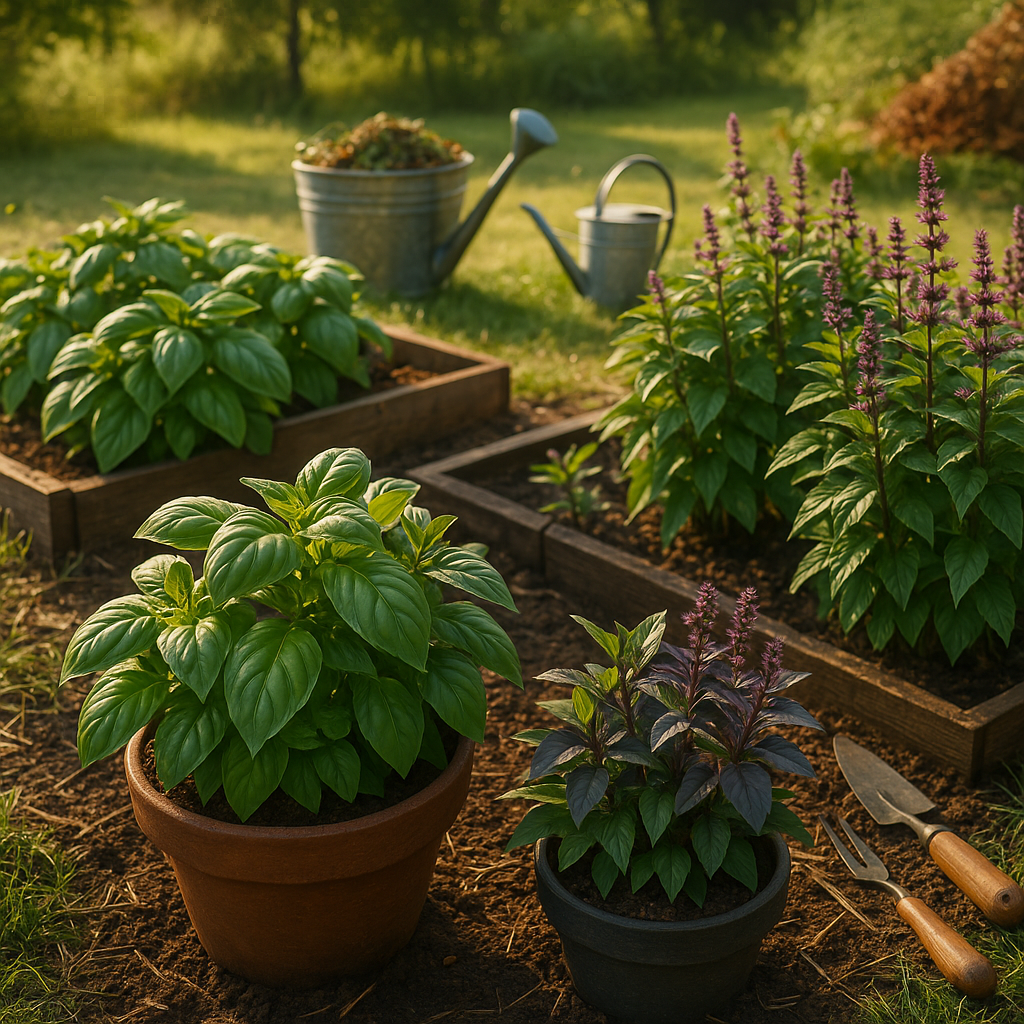
When deciding between Genovese and Thai basil for your garden, consider their unique preferences and growth patterns to achieve the best results. Start by choosing a sunny spot, as both types need at least 6 hours of direct sunlight each day.
For outdoor planting, wait until nighttime temperatures consistently stay above 50°F (10°C) — Genovese basil thrives around 70°F (21°C), while Thai basil tolerates slightly higher heat and humidity. Use well-drained, nutrient-rich soil for both, mixing in compost to improve texture and fertility.
When sowing seeds or transplanting seedlings, space Genovese basil about 12-18 inches apart since it grows bushy and wide, making it ideal for large garden beds or containers. Thai basil grows more upright and compact, so 8-12 inches of space works well, especially if you’re fitting several plants on a sunny windowsill indoors.
Water both basils regularly but allow the top inch of soil to dry out before watering again — overwatering is a common cause of root rot.
Genovese basil usually matures and is ready for harvest in about 60 days, producing large, soft leaves perfect for classic pesto. Thai basil is slightly faster, maturing in 45-60 days with smaller, firmer leaves and purple stems, great for stir-fries and curries.
Indoors, place pots in the brightest window or supplement with grow lights. To manage pests like aphids and spider mites, check leaves often and rinse them off with a gentle stream of water or use insecticidal soap if needed.
Both basils are susceptible to fungal diseases if air circulation is poor, so prune densely packed stems and avoid watering the leaves. For easy picking and bushier plants, pinch off the flower buds as they appear and regularly snip leaves from above a pair of nodes.
In summary, a bit of attention to each type’s habits and environment will reward you with lush, aromatic basil for all your favorite dishes.
Storing and Preserving Basil Leaves
Storing and preserving basil leaves ensures you can enjoy their fresh flavor long after harvest. For short-term use, gently wash and pat dry the leaves, then wrap them loosely in a slightly damp paper towel and tuck them into a resealable bag in the fridge—they’ll stay fresh for up to a week. To maintain that vibrant green color, avoid crushing the leaves or packing them tightly.
If you want to dry basil, tie small bundles and hang them upside-down in a well-ventilated, dark place for about two weeks. Once crispy, crumble the leaves and store them in an airtight jar.
Freezing is another great option—chop basil and freeze it in ice cube trays topped with a little water or olive oil, so you can toss a cube straight into sauces or soups. Homemade basil pesto also freezes beautifully; just spoon it into containers with a thin layer of oil on top and seal.
For an easy herb-infused oil, dunk dry basil leaves in olive oil and keep it in the fridge for up to a week (never at room temperature, which can be unsafe). Curious about vinegars? Steep basil with white wine vinegar for two weeks, then strain for a delicious salad splash.
Each method helps lock in basil’s unique flavor, keeping your favorite dishes bright and fragrant.
Conclusion
Choosing the right basil depends on your needs—sweet basil is versatile and perfect for Italian dishes, while Thai basil adds a spicy kick to Asian cuisine. If you love trying new flavors, grow both to see which suits your palate and fits your recipes best.
In the garden, sweet basil thrives in warm, sunny spots, and Thai basil is more resistant to heat. Don’t be afraid to experiment; swap basil varieties in your favorite dishes for exciting results.
We’d love to hear which basil you prefer and how you use it, so share your experiences and favorite recipes in the comments!
